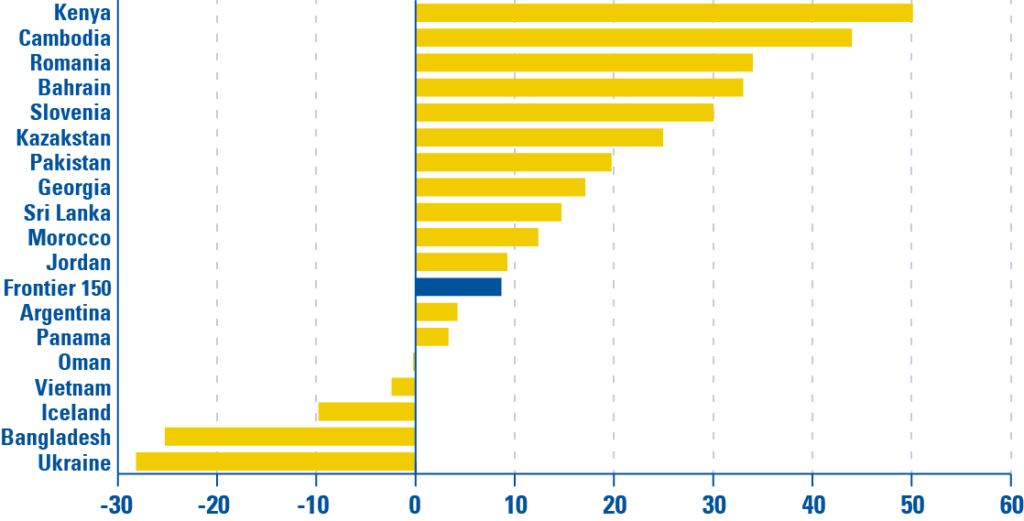Frontier Markets Semi-Annual Outlook
August 2024*
The water is calmer but watch out for waves
While incoming US data increase the prospects of a US recession, a more benign growth slowdown remains our base case. Nonetheless, political risks will continue to dominate in a handful of frontier markets (FM), weighing on their outlooks. The FM universe is diverse and our market preferences are those primed to benefit from global trends underway such as friend-shoring (Vietnam) and decarbonisation (Kazakhstan).
Frontier markets (FM) were caught up in the broad market sell-off at the end of July following the Bank of Japan’s rate hike and softer-than-expected US labour market data. The latter raises the likelihood of a US recession (our working assumption is a 30% probability over the next 6-12 months), but it is not our baseline view. Additionally, the recovery in China is losing steam, while Europe is stagnating. As such, the global manufacturing PMI dropped to 49.7 in July. The latest contractionary reading should provide some caution but the consumer sector is a bright spot, as evidenced by the above-50 global services PMI. As such, we expect an easing in global growth to trend growth rather than an outright sharp deterioration, which should provide some support for FM exports. Moreover, the ongoing fall in global inflation precludes easier central bank policy. The US Fed is primed to cut at their September meeting, which should help soften an already expensive US dollar. Currency pressures and inflationary trends will determine the scale of easing, but easier US policy should afford FM central banks some space to cut rates and support their economies.
Political risks are a constant theme as elections are scheduled in Georgia (October) and Romania (December) this year. The passing of the Transparency Law ahead of the election in Georgia have led to protests and its EU accession plans have been put on ice. In Romania, polls and the results of June’s European parliamentary elections point to the current coalition government retaining power, removing some uncertainty. Beyond FM, the US election in November could produce a second Trump administration which would likely be more hawkish on trade and migration. Given its sizeable bilateral trade surplus with the US, Vietnam would be at greatest risk. Finally in Bangladesh, the resignation of its prime minister in response to widespread protests leaves behind a political vacuum.
Market Strategy
FM equities (MSCI FM 100 Net TR Index) widely underperformed EM equities (MSCI EM Net TR Index) by 12.8% points over February-July. Over the same period, FM also underperformed DM equities (MSCI World Net TR Index). The weakness in FM was concentrated in Vietnam and Iceland. FM equity valuations screen as neutral, with the 12M forward P/E trading at a 20% discount, which is in line with its five-year average.
In terms of country allocation, our preferred markets are Vietnam and Kazakhstan. Vietnam stands to benefit from friend-shoring trends, while our overweight in Kazakhstan reflects the country’s reserves of uranium and thereby exposure to the decarbonisation trend. We keep our underweights in Argentina and Romania as the former grapples with deep-rooted macroeconomic imbalances, and the latter’s deteriorating fiscal situation keeps us wary. Jordan, Slovenia and Sri Lanka were removed from the benchmark S&P Extended Frontier 150 on May 1st, while Pakistan was added on the same date.
We only make one change to our allocation:
- Upgrade Oman to overweight. Valuations are not particularly cheap but have become more attractive over the past six months. The 12M forward P/E for MSCI Oman is trading at a discount close to, but still above, its five-year average. Moreover, the country boasts a robust economy and governance. The national plan under the Oman Vision 2040 suggests a strong economic outlook, while Oman’s ambitious plans to export hydrogen means that it can benefit from the momentum around the decarbonisation trend. We fund our upgrade by reducing our overweight to Kazakhstan.
Chart 1: S&P Extended Frontier 150 Net Total Return USD, Feb 24-Jul 24

Source: S&P
*The publication reflects asset performance up to 31 July, 2024, and macro events and data releases up to 9 August, 2024, unless indicated otherwise.
The information contained herein is obtained from sources believed by City of London Investment Management Company Limited to be accurate and reliable. No responsibility can be accepted under any circumstances for errors of fact or omission. Any forward looking statements or forecasts are based on assumptions and actual results may vary from any such statements or forecasts.